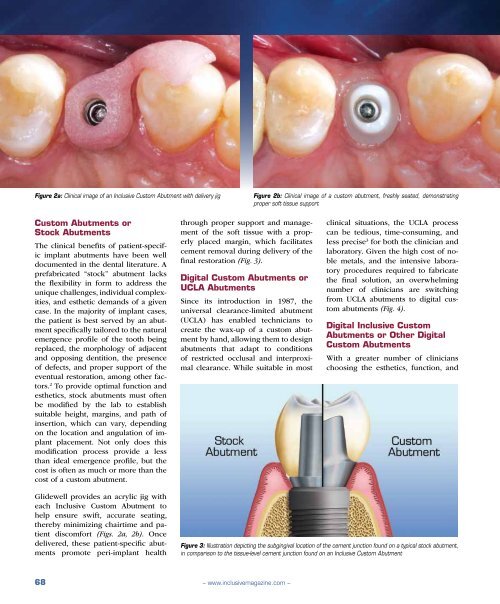PDF Download - Glidewell Dental Labs
PDF Download - Glidewell Dental Labs
PDF Download - Glidewell Dental Labs
Create successful ePaper yourself
Turn your PDF publications into a flip-book with our unique Google optimized e-Paper software.
Figure 2a: Clinical image of an Inclusive Custom Abutment with delivery jig<br />
Figure 2b: Clinical image of a custom abutment, freshly seated, demonstrating<br />
proper soft tissue support<br />
Custom Abutments or<br />
Stock Abutments<br />
The clinical benefits of patient-specific<br />
implant abutments have been well<br />
documented in the dental literature. A<br />
prefabricated “stock” abutment lacks<br />
the flexibility in form to address the<br />
unique challenges, individual complexities,<br />
and esthetic demands of a given<br />
case. In the majority of implant cases,<br />
the patient is best served by an abutment<br />
specifically tailored to the natural<br />
emergence profile of the tooth being<br />
replaced, the morphology of adjacent<br />
and opposing dentition, the presence<br />
of defects, and proper support of the<br />
eventual restoration, among other factors.<br />
2 To provide optimal function and<br />
esthetics, stock abutments must often<br />
be modified by the lab to establish<br />
suitable height, margins, and path of<br />
insertion, which can vary, depending<br />
on the location and angulation of implant<br />
placement. Not only does this<br />
modification process provide a less<br />
than ideal emergence profile, but the<br />
cost is often as much or more than the<br />
cost of a custom abutment.<br />
through proper support and management<br />
of the soft tissue with a properly<br />
placed margin, which facilitates<br />
cement removal during delivery of the<br />
final restoration (Fig. 3).<br />
Digital Custom Abutments or<br />
UCLA Abutments<br />
Since its introduction in 1987, the<br />
universal clearance-limited abutment<br />
(UCLA) has enabled technicians to<br />
create the wax-up of a custom abutment<br />
by hand, allowing them to design<br />
abutments that adapt to conditions<br />
of restricted occlusal and interproximal<br />
clearance. While suitable in most<br />
clinical situations, the UCLA process<br />
can be tedious, time-consuming, and<br />
less precise 3 for both the clinician and<br />
laboratory. Given the high cost of noble<br />
metals, and the intensive laboratory<br />
procedures required to fabricate<br />
the final solution, an overwhelming<br />
number of clinicians are switching<br />
from UCLA abutments to digital custom<br />
abutments (Fig. 4).<br />
Digital Inclusive Custom<br />
Abutments or Other Digital<br />
Custom Abutments<br />
With a greater number of clinicians<br />
choosing the esthetics, function, and<br />
<strong>Glidewell</strong> provides an acrylic jig with<br />
each Inclusive Custom Abutment to<br />
help ensure swift, accurate seating,<br />
thereby minimizing chairtime and patient<br />
discomfort (Figs. 2a, 2b). Once<br />
delivered, these patient-specific abutments<br />
promote peri-implant health<br />
Figure 3: Illustration depicting the subgingival location of the cement junction found on a typical stock abutment,<br />
in comparison to the tissue-level cement junction found on an Inclusive Custom Abutment<br />
68<br />
– www.inclusivemagazine.com –

















